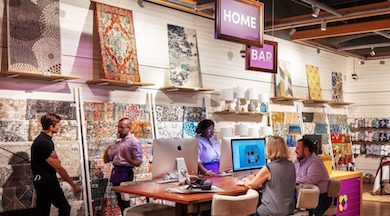NEW YORK -- Online furniture sales are growing at twice the rate of overall e-commerce as consumers move away from shopping in brick and mortar, according to a new research report, called Is Omnichannel the Future for Furniture Retail?, by Coresight Research.
"While almost all of the leading merchants posted steady sales gains in 2019, Wayfair is driving category growth and generated a third of online furniture sales; long-time e-commerce discounter Overstock is struggling," said Matt Pace, senior director, 1010data, a company that provides data and analytical intelligence to hedge funds, asset managers and the retail industry.
"E-commerce gains have been fueled by an explosion of consumer choice and selection that would be overwhelming for consumers in physical stores, not to mention impossible for stores to display," he added, noting that furniture sales in 2019 are expected to total $18.8 billion, a 13 percent increase from a year earlier. "To compete with the selection offered by online-only merchants, brick and mortar merchants have shifted to carrying only a fraction of their inventory in-store, and instead are driving consumers to shop online."
Among various furniture and home furnishing retailers reviewed, the report found that most, though not all, major surveyed retailers are investing in omnichannel transformation and are considering how, if at all, this transformation is essential for long-term survival.
"E-commerce in the furniture sector continues to grow rapidly. However, the influence of brick-and-mortar stores has not waned meaningfully, and the offline channel continues to be the most popular for consumers when buying furniture," the report concluded. "The shopping journey is becoming more complex as cross-channel shopping trends continue to evolve, forcing retailers to rethink how they are engaging with customers.
"In today's retail environment, both offline- and online-focused retailers are making efforts to firm up their offerings in their respective primary channels. Alongside this though, they are also making significant investments into building an omnichannel presence, in order to meet customer expectations."
Furniture is the top product category, at 23 percent, that consumers research online and then purchase in stores, according JRNI research.
IKEA & WILLIAMS SONOMA INVEST IN ONLINE
Among the home furnishings players reviewed in the Coresight report, Ikea plans to grow its reach to about 3 billion customers by 2025, and to meet that goal the Swedish retailer is investing heavily in enhancing its digital channel.
Coresight explained that while omnichannel retail offers a seamless experience and accounts for spillover between channels, multichannel retail offers online and offline channels typically operated independent of one another.
Ikea, the studies authors point out is a omnichannel torchbearer and to achieve its growth target, it is investing in its digital offering and has rolled out several initiatives to meet its goal. It launched an augmented reality-powered application called Ikea Place in September 2017 that allows customers to visualize how Ikea products would fit in their homes via 3D renderings. And today the app has been upgraded with new features that marry augmented reality with curated and personalized home-furnishings tips and recommendations. Also in the fall of 2017, the company acquired TaskRabbit, a platform that helps users to connect with workers who can deliver and assemble furniture. And, in May 2019, Ikea began testing a new shoppable virtual reality app.
"Ikea's e-commerce sales increased by 46 percent and constituted 11 percent of total sales of $40.5 billion in fiscal year 2019; the company grew its total sales by 5 percent in the same year. It also saw 10 percent growth in website visitors, which totaled 2.6 billion, while in-store traffic stayed steady at 839 million," the report stated.

Williams Sonoma's online site includes a to-scale room planner that lets shoppers place furniture, rugs and more.
Likewise, Williams Sonoma also is focusing on an omnichannel strategy, building on its brick and mortar base. "The company first launched an e-commerce website in 1999, and has since been investing in this channel to a point where e- commerce now accounts for almost 57 percent of the company's revenues, according to its third quarter earnings call in November 2019," the Coresight report stated.
Today customers are able to use Williams Sonoma services such as free product returns and buy online, pick up in store (BOPIS). The company launched BOPIS across all 221 stores under the Williams-Sonoma banner at the end of 2017. In that year, the company also debuted its Design Crew, a program offers customers free consultations with a design expert. Design Crew experts help customers to choose appropriate products and services -- across its eight brands -- for decorating, renovating, entertaining, cooking and gifting.
At home improvement giant, Home Depot, 2017 was also a major year for digital advances. In December of that year, It announced a three-year, accelerated investment program called "One Home Depot," which is "designed to transform the company into a more digital-centric retailer. The program aims to allow customers to move seamlessly between digital and physical worlds," the report stated. Part of One Home Depot included store enhancements, e-commerce developments, delivery offerings and an effort to appeal to its professional customers, such as renovators/remodelers, general contractors, handymen and tradespeople. "According to Internet Retailer's 2019 Omnichannel Report, Home Depot ranked among the top three companies last year in terms of omnichannel service execution."
E-COMM CHALLENGES
In the U.S. last year, e-commerce accounted for 17 percent of furniture and homewares sales, up from 16 percent a year earlier, with brick and mortar remaining the preferred channel for buying furniture. The absence of tactility in online buying limits sales, the authors state, as do the high cost of product returns.
"Although the advent of augmented and virtual reality services is helping to alleviate consumer uncertainty around purchasing furniture online, the high cost of returns continues to be a significant challenge for online retailers, as they do not have physical stores that can double up as showrooms," the study stated.
However, researching products online and then buying them offline is a trend expected to continue. The Coresight study pointed to JRNI's Modern Consumer Research Report 2019, which found that 75 percent of U.S. consumers sometimes or often research online and purchase offline, compared to 57 percent of shoppers who sometimes or often research offline and then purchase online, across different categories.
"The survey found that 13 percent of U.S. consumers selected furniture as the category for which they most often research online and purchase in store, reflecting that furniture is a considered purchase for which consumers are keen to gather information, compare products and experience items before buying," it stated.
WAYFAIR TESTS OFFLINE WATERS, WHILE RH FOCUSES ON PHYSICAL SETTINGS

Wayfair's recently opened inaugural store outside Boston features a Home Bar staffed with design savvy Design Consultant and aVR experience developed by the Wayfair Next Lab.
At Wayfair, one of the digital first retailers, the Boston-based company has expanded its reach offline to enhance overall sales and sustain growth. "Leading e-commerce-focused furniture and home furnishing retailers -- such as Wayfair and Casper -- are now trying to increase their market share by opening physical stores and establishing a brick-and-mortar presence."
After experimenting with pop-up stores, Wayfair opened its first full-service brick-and-mortar store in the Natick Mall in Natick, Massachusetts, last summer.
In contrast to many home retailers, RH is bucking conventional wisdom and remains focused on its physical stores, opening new galleries and concept stores. Despite the company's "feeble" digital capabilities, as described in the report, it recorded record revenues of $677.5 million in its third quarter ended November 2, 2019, a 6.4 percent increase over the third quarter of the previous year, an adjusted operating margin of 13 percent, a 340 basis-point increase year over year, the Coresight found.
"It is becoming increasingly apparent that modern-day shopping habits and trends such as researching online and purchasing offline and vice versa are continuing to rise. In this evolving retail environment, the retailers that are therefore likely to be the most successful are those that have an effective omnichannel strategy in place," the study found.
"While there may be outliers like RH, they are likely to be the exception rather than the rule, and it remains to be seen whether circumventing the omnichannel route will pay dividends over the longer term."
To learn more about Coresight Research or to access the full report visit coresight.com.